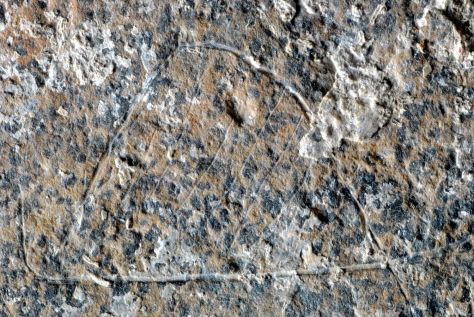NewsNext Previous
A 13,000 years old map of a hunter-gatherer campsite
It is a schist slab showing seven semicircular motifs that, according to their shape and proportions, can be interpreted as huts
This engraving would be the first representation of a human social group recorded to date
This mobile art piece was found in the Molí del Salt site (Vimbodí i Poblet, Tarragona) during an archeological excavation carried out by the IPHES
The archeological excavations carried out at the Molí del Salt site (Vimbodí i Poblet, Catalonia, Spain) have uncovered a unique piece of mobile art at an Upper Paleolithic level with a chronology ranging between 13,000 and 14,000 years before present. The piece, whose study has been just published in PLOS ONE, is a schist slab, 18 cm long and 8.5 cm wide, that presents seven engraved semicircular motifs. Because of its shape and proportions, these motifs have been interpreted as huts and, therefore, this engraving would be a representation of a hunting-gatherer camp, the first one recorded to date.
The Molí del Salt excavations began in 1999 have had the support of the Generalitat de Catalunya, the Conca de Barberà Regional Council, the City Council of Vimbodí i Poblet, and SOREA company. These works have been directed by Manuel Vaquero, researcher in the Rovira and Virgili University (URV) and the Catalan Institute of Human Paleoecology and Social Evolution (IPHES).

According to the analysis carried out by Marcos García-Díez (University of the Basque Country) and Manuel Vaquero (URV/IPHES), the shape and metrics of the semicircular motifs show a close formal similarity with the huts built by various groups of hunter-gatherers known by ethnographic accounts (Kalahari Bushmen, Australian aborigines …). The number of huts on the slab (seven) also coincides with the usual size of a hunter-gatherer camp.
The Molí del Salt object is a singularity in the context of Paleolithic art, which is dominated by animal figures and abstract signs. Moreover, it informs us about a secular art, far from the ideological implications that are often attributed to the Paleolithic animal representations. Manuel Vaquero points out that “if we take into account that camps are the spatial manifestation of the hunter-gatherer social structure, the Molí del Salt slab can be considered the first representation of a social group known to date”.
Marcos García-Diez adds that “the technical analysis indicates that the seven motifs were engraved in a very short time using a similar technique and instrument. This suggests that the engraving would show a reality that the artist would have before their eyes”. It would be therefore one of the first documented examples of landscape art, with the particularity that this time the depicted landscape was exclusively human.
Reference
García-Diez, M., Vaquero, M. “Looking at the Camp: Paleolithic Depiction of a Hunter-Gatherer Campsite”. PLOS ONE (http://dx.plos.org/10.1371/journal.pone.0143002)


